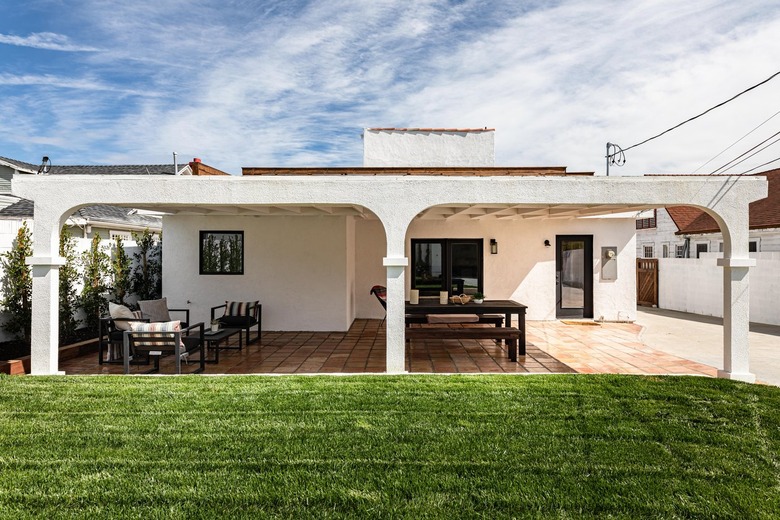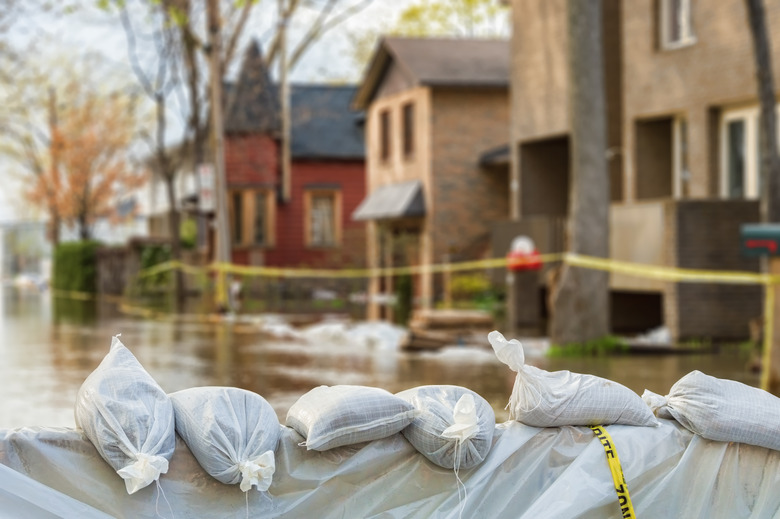12 Ways To Protect Your Home From Flooding
Are you worried that your home might be susceptible to flood damage? If you live in a flood-prone area, you'll likely need flood insurance through the National Flood Insurance Program, but that only helps once high water enters your home. Home improvement projects to keep floodwater out of your home save you a call to your insurance agent by helping to prevent flood damage in the first place. You might not be able to move your home to higher ground, but you can undertake floodproofing projects indoors and outdoors to reduce the risk of damage whether or not you live in a flood zone.
1. Assess Your Flood Damage Risk
1. Assess Your Flood Damage Risk
The Federal Emergency Management Agency creates flood maps, which help determine the risk of flooding. Since regular homeowners' insurance policies don't usually cover flood damage, homes in a floodplain or a high-risk area need special flood insurance. Knowing that you're in a flood-prone area indicates that you need to take precautions, but even areas outside of flood zones can still experience home flooding and can benefit from protective measures. Heavy rains can cause flooding even in areas that aren't in a flood zone.
2. Seal Cracks and Gaps
2. Seal Cracks and Gaps
You can't always keep water from reaching your home, but you can make it more difficult for water to get inside the structure. Homes can have lots of gaps and foundation cracks, which let water flow into the home easily. Use hydraulic cement or masonry caulk to fix minor foundation cracks or hire a contractor to assess and fix major foundation cracks. You can also apply waterproofing sealants over your basement walls.
Windows, doors and utilities present additional areas to address for flood protection. Caulk around windows and doors to seal any gaps. Look for spots where pipes or cables run into your home and seal any gaps around the holes where they enter.
3. Install a Sump Pump
3. Install a Sump Pump
A sump pump can help keep your basement dry by pulling excess water out of a collection pit below the basement floor and pumping it out of and away from the house. Having a battery backup on your sump pump ensures that it keeps working (for a limited time) during a power outage. Some sump pumps also have Wi-Fi functionality and can alert you remotely if they stop working.
4. Add a Backflow Valve
4. Add a Backflow Valve
Installing a backflow valve on each pipe going out of your home can stop water from backing up into your home. These special valves only allow the water to flow one way in your drain lines, including any floor drains and your main drain that leads to the sewer main. They stop floodwater from coming back into your home through drains, toilets and sinks, which can help keep your home dry during heavy rain.
5. Elevate Your Appliances and Utilities
5. Elevate Your Appliances and Utilities
You might not be able to keep all floodwater out of your home, but you can reduce the amount of water damage done to major components of your home. Elevating items such as water heaters, washers and dryers, heat pumps and furnaces can keep them away from high water. Moving your laundry room to an upper floor and moving your HVAC system to the attic or an upper floor is a more involved project, but it can help you save those appliances in case of a flood.
Ensure all appliances are on a stable foundation and properly secured. This includes indoor and outdoor fuel tanks, which can float away and cause fuel leaks or damage when flooding occurs.
Keeping your electrical system above the potential flood level also reduces the risk of flood damage. This includes your circuit breaker box, outlets and switches. A licensed electrician can help you rework your electrical system to elevate the components safely.
6. Fix Your Lawn Grade
6. Fix Your Lawn Grade
The slope and grade of your lawn determine how water will flow when it rains. Water naturally follows the path of least resistance, which means it will flow downhill. If your land slopes right toward your home or there are low-lying spots near your home's foundation, that's where the water will go.
Changing the grade of the lawn can redirect the water so it flows away from your home instead of toward it. If the soil dips down and forms a depression near your foundation, build up the soil to create a slope away from it. If you have a major grading problem across your lawn, hire a professional to regrade it and improve water flow.
7. Redirect Water Runoff
7. Redirect Water Runoff
Water naturally runs with gravity, so redirecting water runoff that goes toward your home can reduce your flood risk. Adjust downspouts to direct water away from your home. You can extend the downspout to carry the water farther from your foundation. Using a rain barrel to collect the water from your gutters is another way to control runoff and reduce your water consumption since you can use it to water plants. Adding an overflow hose on the rain barrel allows you to divert excess water away from the house if the barrel becomes full in heavy rain.
If you live on a sloped property, the water might naturally run toward your home. Fixing the grading should help, but you can also help direct runoff through swales, which direct water where you want it to go. Swales are essentially shallow ditches with gently sloped sides to capture water. Fast-draining soil and plants growing in the swale encourage water to soak down into the soil, and the swale can also incorporate a perforated pipe to help with drainage. The swale should direct any remaining water away from your home.
8. Landscape to Ease Water Runoff
8. Landscape to Ease Water Runoff
Plants in your landscaping help slow water runoff and encourage the water to filter down into the soil instead of running toward your house. A rain garden is designed specifically for this purpose and is often created at the bottom of slopes or in low-lying areas where water pools naturally. The combination of plants and mulch slows down the water and directs it down into the soil, preventing it from rushing toward your home's foundation.
9. Reduce Concrete Slab Areas
9. Reduce Concrete Slab Areas
Large concrete areas, such as driveways and patios, prevent water from soaking into the ground. They cause the water to run off the sides and provide less surface area to soak into the ground. The water runoff can overwhelm storm sewers during heavy rains, which can back up with excess water and cause flooding.
Instead, create a stone or paver patio to get the hard surface you want while letting water make its way into the soil. Gravel, mulch and other permeable materials work well for walkways or other ground coverings. For a driveway, options include gravel, porous asphalt and porous concrete. Reducing hard-surface areas in favor of greenery also helps.
10. Keep Drains and Gutters Clear
10. Keep Drains and Gutters Clear
Checking your gutters, drains and drainage ditches regularly can prevent a backup that forces water into your home. To prevent overflow, clean your gutters at least twice per year. If you have lots of trees near your home, check the gutters more frequently to remove leaves, sticks and other debris that can cause water to spill over the edges.
Also check indoor floor drains frequently to make sure they're clear of debris. Pour water down the drains to ensure they drain quickly if you don't use the drain often. If you have storm sewers or drainage ditches outside your home, routinely clean out any debris that collects in them. Having the drains free of debris makes it easier for them to keep up with water flow.
11. Keep Sandbags Handy
11. Keep Sandbags Handy
If you live in a flood-prone area, having sandbags on hand can help keep floodwater at bay. You can sandbag your home faster if you already have sandbags available when the water starts to rise — especially because those items tend to sell out quickly when a storm is on its way. The sandbags might just be enough to keep high water from entering your home under your doors or through lower windows.
12. Add a Flood Sensor
12. Add a Flood Sensor
Even with flood damage prevention methods, water can sometimes make its way inside your home. Sometimes, it's an internal issue with a leak in your plumbing system. Flood sensors — which are often an add-on option to your smart home equipment or home security system — detect the issue early and alert you so that you can take action to prevent more serious water damage. If you have an emergency preparedness plan in place, the flood sensors can even let you know it's time to use it.


